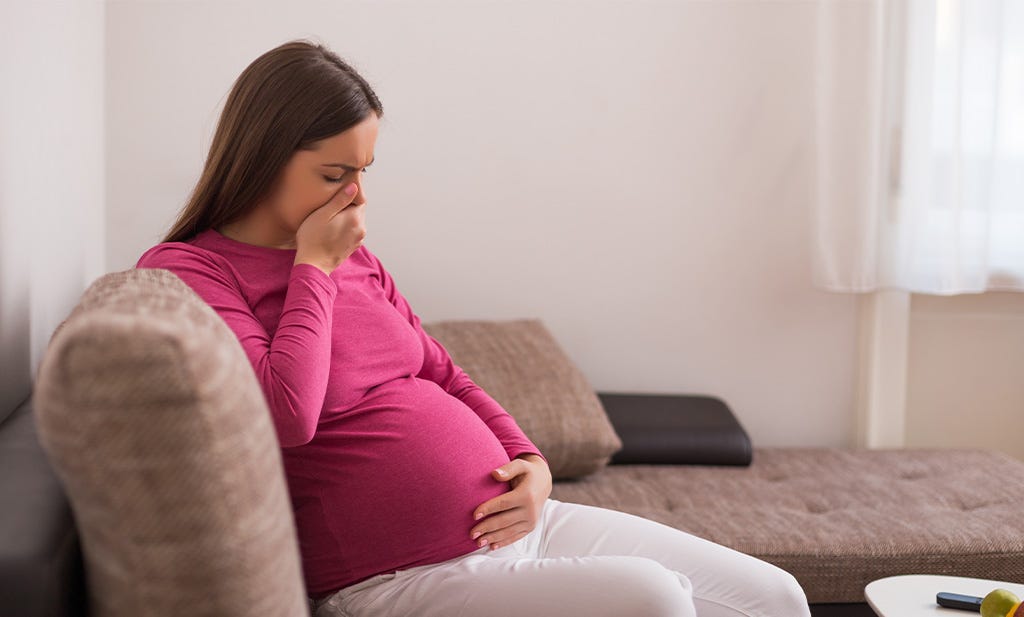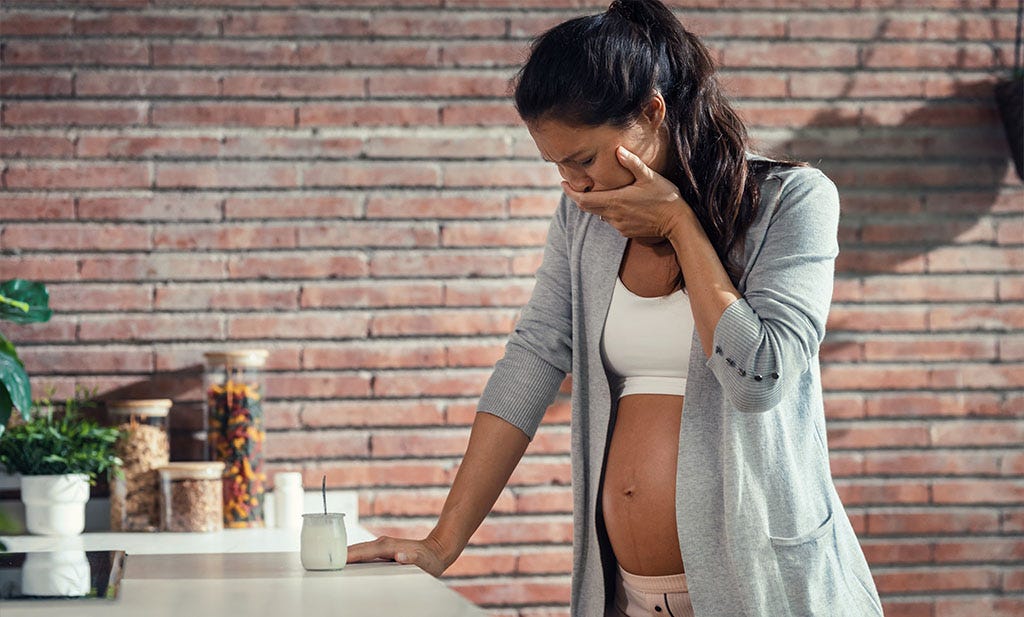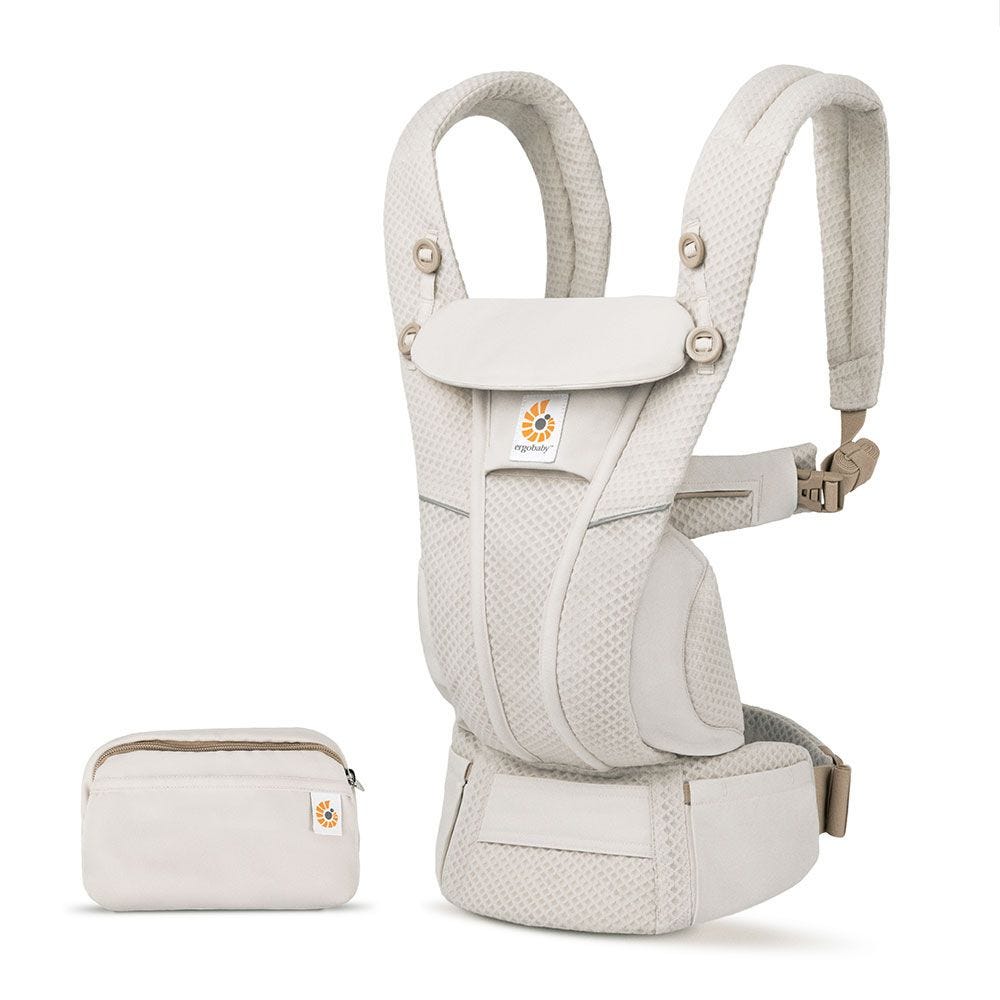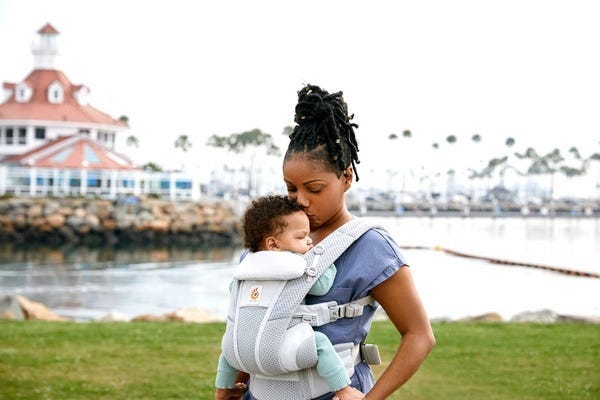
One of the most common symptoms of pregnancy (alongside tiredness) is nausea or ‘morning sickness’. Most people experience some kind of sickness during pregnancy. Around 70 to 80 per cent experience nausea in early pregnancy, in the morning or throughout the day. Around half of those affected also experience vomiting (emesis) in addition to nausea. Some are completely spared this discomfort and others suffer from sickness beyond their first trimester. It’s most common during the first 12 – 20 weeks of pregnancy. After that, for most people, that queasy feeling usually subsides. But a small number develop a condition called hyperemesis gravidarum (HG) and suffer from prolonged and severe nausea and vomiting far beyond the usual ‘morning sickness’.
In today's blog article, with the help of our expert and midwife Katrin Ritter, we want to take a closer look at this often-debilitating pregnancy nausea. But perhaps most importantly we’ll be sharing some ideas for what might help you if you’re experiencing typical ‘morning sickness’!
Emotional Benefits of Getting Outside
Spending time in nature with your baby can strengthen the bond between you. The simple act of holding your baby close, feeling their warmth, and sharing new experiences together can create strong emotional connections. It’s also a wonderful way to reduce stress and improve your mood. When my littles were extra fussy, I’d take a walk around the neighborhood. Even though I don't live in an area with trails and surrounded by nature, simply behind outside changed everything. A little vitamin D does wonders!
Cognitive Development
Nature is a sensory wonderland for babies. The different sights, sounds, and smells can stimulate your baby’s senses and promote cognitive development. Watching leaves rustle, hearing birds chirp, and feeling the texture of a tree bark can all contribute to their learning and development.
When does morning sickness start?
One of the most common questions people have, sometimes even before they fall pregnant, “when does morning sickness start?”. There’s no definite answer as pregnancy nausea is as individual as pregnancy itself. There is no specific starting point. Some people experience it before the pregnancy test, others only in the fifth or sixth week of pregnancy and others later still. It often becomes most unpleasant between the eighth and eleventh week of pregnancy.
What causes morning sickness / hypermesis gravidarum?
One of the possible reasons why pregnancy nausea can occur in the first place is the pregnancy hormone HCG which reaches its peak in the eleventh week. After this, the concentration drops and the nausea often subsides - in most cases. And because every person reacts differently to the change in their own hormone balance (oestrogen, progesterone and HCG) – we’ve talked about this before in relation to pregnancy cravings - the type, severity and duration of morning sickness also varies for every person.
However, the exact cause of discomfort during pregnancy has not yet been clearly established. In addition to the rapid increase in the pregnancy hormone HCG, low blood sugar levels, stress, stomach sensitivity, deficiency symptoms and poor nutrition are also on the list of suspects. However, last year an international team of researchers analysed the blood of pregnant people and found that a hormone produced by the foetus called GDF-15 can be linked to nausea and vomiting during pregnancy. Thus, sensitivity to this hormone may also contribute significantly to the risk of excessive nausea and severe vomiting (hyperemesis gravidarum).
What helps if I’m suffering from morning sickness?
While there’s no cure entirely, you don’t have to just live with morning sickness, or hyperemesis gravidarum for that matter. If you’re suffering then speak to your GP as soon as you can, and reach out to an organisation such as Pregnancy Sickness Support for help. We’ve also compiled a list of things below that might make the discomfort a little more bearable:
Small, healthy and high-fibre meals
To keep your blood sugar levels stable, aim to eat several small meals a day. This also puts less strain on your stomach. High-fibre foods such as wholegrain products, fruit and vegetables and protein are particularly good for this.
Bitter foods
Sour and bitter could be other game changers for morning sickness. Add a few slices of lemon or grapefruit to your water or try artichokes or rocket. Their bitter substances could alleviate your nausea somewhat. But don't overdo it with citrus fruits: excessive consumption of acidic foods can cause heartburn and damage your teeth. Speak to your midwife if you’re unsure about what’s safe.
Avoid spicy and fatty foods
Want to go easy on your stomach? The best way to do this is to avoid spicy, fatty and sugary foods as much as possible. Your stomach will thank you.
Drink enough
Even without, but especially with morning sickness, 1.5 to 2 litres a day is a good goal and important for you and your baby. Non-carbonated drinks that are free from added sugars such as water, herbal teas (no more than one to two cups a day) and fresh juices are ideal for this. Drinking warm water before getting up can also help.
Ginger
Drinking a cup of ginger tea can sometimes alleviate some of the symptoms of morning sickness. Or you can try it in the form of sweets, as a spice in food or simply added to water. But again, please only consume it in moderation, and pregnant women with blood clotting problems and with a risk of premature labour should avoid it completely.
Eat and drink before getting up
If you feel nauseous mostly in the morning then treat yourself to a few snacks and a drink in bed. Plain biscuits, some rusks or savoury crackers will get your circulation going and your blood sugar levels on track and hopefully prevent any early morning dashes to the bathroom.
Avoid stress
Your body is running at full speed during pregnancy. That's why you should give it and yourself plenty of rest and relaxation. Stress is poisonous and can also be responsible for that unpleasant queasy feeling - whether physical, emotional or psychological. So plan enough breaks in your everyday life and use tools to relax such as getting outdoors, meditation or pregnancy yoga.
Acupuncture and acupressure
Speaking of relaxation: acupuncture and acupressure also help you to wind down. Targeted acupuncture needles and targeted pressure can also counteract morning sickness. Talk to your midwife about this, they may have recommendations.


Hyperemesis Gravidarum
There are those for whom no home remedies help. They are so badly affected by nausea and vomiting that they can hardly get through everyday life and are only able to eat and drink to a limited extent. This is known as hyperemesis gravidarum (HG), and often needs hospital treatment. Exactly how many pregnant women get HG is not known as some cases may go unreported, but it's thought to be around one to three in every 100. Signs and symptoms of HG include prolonged and severe nausea and vomiting, dehydration and weight loss. If you think you might have HG then seek help from your midwife or doctor as swiftly as you can. They will be able to assess the situation and will be able to make a plan.
Can morning sickness harm you or your child?
The short answer is probably not. Your body is incredibly clever and does everything it can to look after your baby. If you have hyperemesis gravidarum then your doctor will be able to give you more information. If you have any worries about yourself or your baby contact your midwife and they’ll be able to help. Otherwise, the best you can do is try and healthy and balanced diet and take care of yourself.
Not just ‘morning sickness’
We want to preface this part of our blog by saying that there is mention of pregnancy termination and serious mental health concerns coming up. If that will cause you distress or you’re not in the right place to read it, please skip straight past to the next heading.
Pregnancy sickness is a scale and it can’t all be lumped under the banner of ‘morning sickness’. That term risks minimising and invalidating the hardship of those who truly suffer with sickness.
For example, a survey developed as a collaboration between the BBC and the Pregnancy Sickness Support charity, was analysed by researchers from King's and Guy's and St Thomas' NHS Foundation Trust and revealed the serious and profound impact that HG has on people’s lives.
4.9% of participants terminated wanted pregnancies due to the severe effects of HG. This statistic highlights the distressing reality faced by many who find themselves overwhelmed by the condition. Mental health struggles were also prevalent among the study’s participants. The relentless symptoms of HG can lead to anxiety, depression, and feelings of helplessness. 19 participants in the study stated that they 'hoped to not wake up each morning'. 184 women said their experience resulted in them making the decision not to have another baby in the future.
While this is the extreme end of the scale, the term ‘morning sickness’ does not adequately characterise the experience of many many people. Even those who do not suffer from hyperemesis gravidarum are often sick at all times of day and for many weeks with varying degrees of severity. It can be debilitating and overwhelming even without an HG diagnosis. So perhaps it’s time to lay the term ‘morning sickness’ to bed in favour of something that more accurately describes this condition.
Hyperemesis gravidarum, ‘morning sickness’ or somewhere in between
We’ve talked a lot about the potential severity of pregnancy sickness but an important thing to remember is that if you experience no sickness or nausea at all, or only a little, this doesn’t mean that there is anything wrong! Every body deals with hormonal changes differently so it’s not a given that you’ll experience sickness.
If you have hyperemesis gravidarum then unfortunately it’s likely that most of the tips above won’t do much to help. Your doctor will be able to advise you the best course of action and what might be able to be done. If that’s you and you’re reading this then all we can say is that we see you, we know your struggle, and we are standing in solidarity with you.
And if you land somewhere in between these camps, as most people do, then hopefully you find some things that work for you and that whatever nausea or sickness you experience ‘only’ lasts a few weeks so you can really enjoy the experience of being pregnant. Good luck!
Sources:
Hebammenkunde, Stiefel et al., 6. Auflage, Thieme
Benefits of Bringing a Stroller
- Storage Space for Gear: Ample room for carrying all your essentials like a diaper bag, beach toys and more.
- Shade and Weather Protection: Built-in canopies to shield your baby from the sun when they are lounging.
- Options: If you have more than one kid, you can stroll with one and carry the other. Or, if you’re getting warm or your little one is getting fussy, you can switch up their position from stroller to carrier or vice versa.
Safety Tips for Strollers
- Ensure your stroller is in good working condition. Make sure buckles are still buckling and that there are no rips or holes that could compromise your baby’s safety.
- Use sunshades or bug nets to protect your little one’s skin.
- Securing the baby properly: always buckle up your baby for safety even if you think they are old enough to go without the buckle.
Combining Baby Carriers and Strollers
For the ultimate flexibility, consider using both a baby carrier and a stroller on your outings.
Combining both options allows you to adapt to different situations. Use the carrier for more rugged trails and switch to the stroller for smoother paths or when your baby needs a nap.
Transition Tips
- Smooth Transitions: Plan stops where you can easily switch from carrier to stroller.
- Pack Light: Only bring essentials to make transitions easier.
Tips for a Successful Adventure
Planning Ahead
- Route Planning: Choose baby-friendly trails and parks. Check local mom groups or outdoor groups and get recommendations for the best outings for kids.
- Check Weather Conditions: Avoid extreme heat or unpredictable weather. Even with our most breathable carriers, when it’s hot, it’s hot. And having two bodies against each other in the heat will be naturally hot and sticky already.
- Packing Checklist: Include diapers, snacks, water, sunscreen, and a first-aid kit. These all-position carriers have storage pockets where you can fit some of the items easily!
- Stay Hydrated and Nourished: Pack healthy snacks to keep energy levels up and bring plenty of water for both you and baby.


Summer adventures with your baby are a wonderful way to create lasting memories and enjoy the beauty of nature together. From baby carriers to strollers, Ergobaby products are designed to provide comfort and ease for both you and your little one. So, gear up, get outside, and explore the world with your baby by your side.
Ready to embark on your own summer adventures? Check out Ergobaby’s range of baby carriers and strollers to find the perfect match for your family’s needs. Visit our website today and start planning your next outdoor excursion!




















